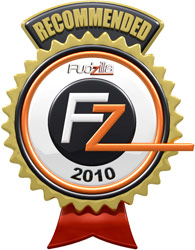Index


Review: Sandforce SF 1200 based
Today we’ll talk about Vertex 2 SSD drive. Vertex 2 is based on the new architecture with Sandforce SF 1200 controller, unlike the original Vertex which uses Indilinx Barefoot controller. OCZ and many other manufacturers have opted on Sandforce controller since it currently offers a great bang per buck.
Compared to its predecessor, the Vertex 2 has an upper hand when it comes to sequential and random read/write ratio. Writing 4k files on Vertex 2 reaches 50,000 IOPS, which should theoretically result in better OS responsiveness.
Vertex 2 drive offers quality, reliability and durability, and the name Vertex looks set to stay for a while. Vertex series still offers solid performance and it’s one of the first SSDs with garbage collection and TRIM, the later being native on Vertex 2. TRIM feature is a standard feature on new controllers and it helps maintaining the best possible performance. Furthermore, it runs great combined with Windows 7.
Vertex 2 uses Sandforce 1200, which is the reason why first SSDs based on it had capacities of 50GB and 100GB, rather than 60GB and 120GB like we’re used to with other drives. In the meantime, Sandforce controller has been improved so OCZ now offers Vertex 2 disks with standard capacities as well as the previously mentioned, 50GB and 100GB ones.
Specs say Vertex 2 reads and writes at 285/275 MB/s respectively, whereas sustained write is at 250MB/s. Thanks to Sandforce, capacity won’t affect read and write speeds, except on 400GB and 480GB models where read/write is 250/240 MB/s and sustained write is 200MB/s.
OCZ’s web portal lists Vertex 2 drives starting from 50GB up to 480GB. Performance difference between the standard and non-standard capacity drives is nonexistent, but as usual – more space means higher pricing.
So, depending on your needs, you can treat yourself to as much as 8 different flavors: 50GB (OCZSSD2-2VTX50G), 60GB (OCZSSD2-2VTXE60G), 100GB (OCZSSD2-2VTX100G), 120GB (OCZSSD2-2VTXE120G), 200GB (OCZSSD2-2VTX200G) 240GB (OCZSSD2-2VTXE240G), 400GB (OCZSSD2-2VTX400G) and 480GB (OCZSSD2-2VTXE480G).
50GB and 60GB capacity Vertex 2 drives are potential targets for notebook/desktop users who want to improve their OS experience, whereas for mass data storage or entry level enterprise application, users can turn to 100GB and higher capacity drives.
Vertex 2 uses MLC flash memory, with no cache memory on the disk except for undeclared amount of integrated cache memory on the controller. As far as reliability and data loss prevention is concerned, the developer claims all capacities are equally good. In fact, OCZ lists a 2 million hour MTBF for Vertex 2 and offers a three year guarantee.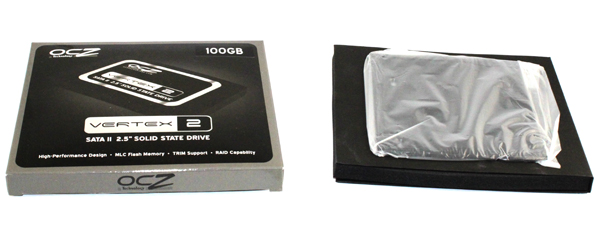
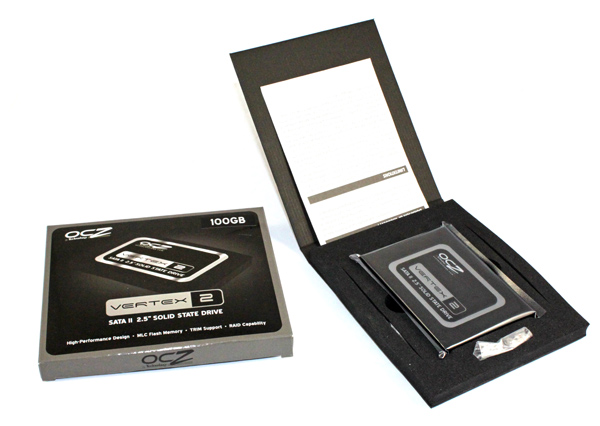
The drive we’re talking about today is OCZ’s Vertex 2 (OCZSSD2-2VTX100G). It is a 2.5’’ slim design and comes in black color. In case you missed it, write speeds are at 285 MB/s, read speeds at 275 MB/s and sustained write goes up to 250 MB/s. It’s optimized for writing 4K files, so maximum aligned 4K IOPS stands at 50.000 IOPS.
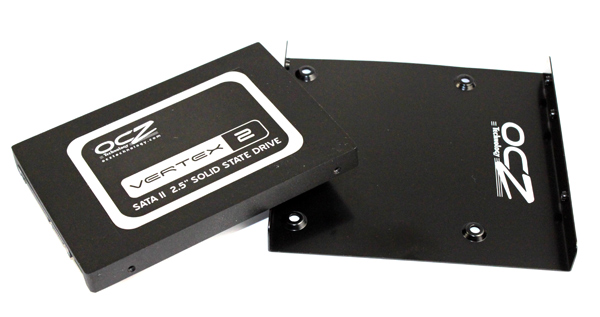
The drive consumes only 0.5W in idle but it doesn’t get much higher during operation either – only 2W. You’ll probably learn to appreciate this if you use it in a laptop. The drive weighs 77g and measures 99.8 x 69.63 x 9.3mm.
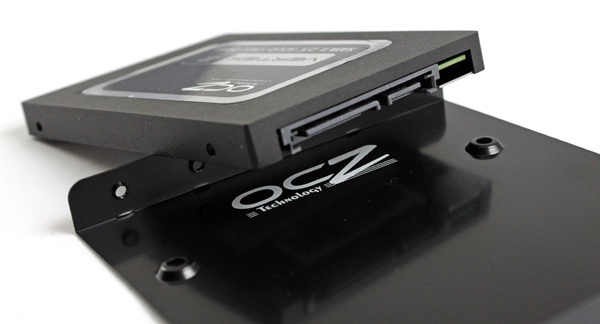
In the box we found a drive tray, which will certainly make mounting the drive in various cases easy.
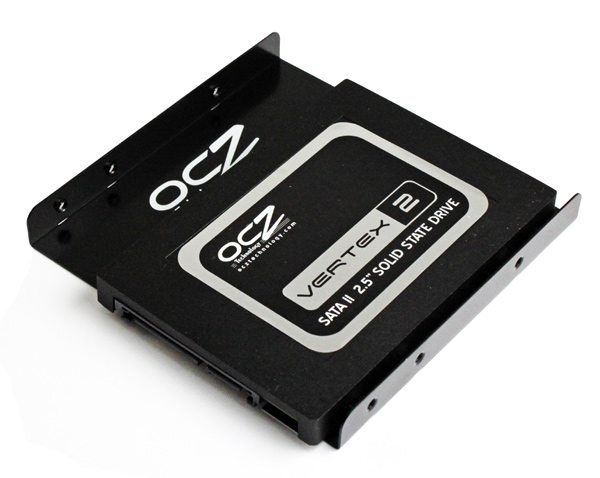
Before we move onto our tests, let’s review Vertex 2’s specs:
- Available in 50GB to 400GB capacities
- Available in 60GB to 480GB extended capacities
- Native TRIM support
- Max IOPS Firmware
- Seek Time: .1ms
- Slim 2.5" Design
- 99.8 x 69.63 x 9.3mm
- Lightweight: 77g
- Operating Temp: 0°C ~ 70°C
- Storage Temp: -45°C ~ +85°C
- Low Power Consumption: 2W in operation,
0.5W in standby - Shock Resistant up to 1500G
- RAID Support
- Included 3.5" Desktop adapter bracket
- Compatible with Windows XP, Vista, 7, and Linux
- MTBF: 2 million hours
3-Year Warranty
50-240GB Max Performance:
- Max Read: up to 285MB/s
- Max Write: up to 275MB/s
- Sustained Write: up to 250MB/s
- Random Write 4KB (Aligned): 50,000 IOPS
400-480GB Max Performance:
- Max Read: up to 250MB/s
- Max Write: up to 240MB/s
- Sustained Write: up to 200MB/s
- Random Write 4KB (Aligned): 22,500 IOPS
Part Numbers:
- 50GB - OCZSSD2-2VTX50G
- 100GB - OCZSSD2-2VTX100G
- 200GB - OCZSSD2-2VTX200G
- 400GB - OCZSSD2-2VTX400G
Extended Capacities: - 60GB - OCZSSD2-2VTXE60G
- 120GB - OCZSSD2-2VTXE120G
- 240GB - OCZSSD2-2VTXE240G
- 480GB - OCZSSD2-2VTXE480G
-
HD Tune
HD Tune isn’t a reliable tool for getting exact R/W values in SSD drives, as it has a tendency to show higher or lower than actual values, but does give you a general performance framework. Vertex 2 scored an average read of 219.2 MB/s and average write speed of 211.7 MB/s.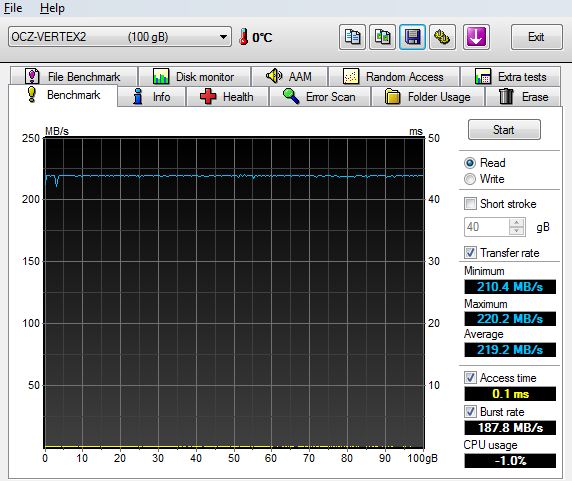
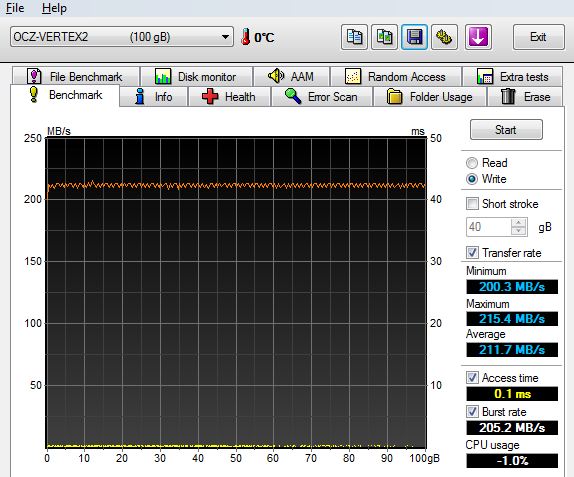
Random Access test confirms Vertex 2 drive’s speed with 4KB files, where we see speeds of over 30MB/s.

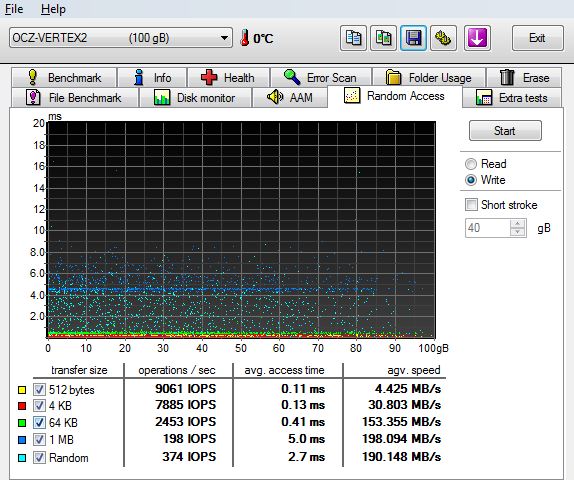
HD Tune Pro’s File benchmark reports read speeds of almost 270 MB/s, whereas write speeds are about 240 MB/s. At the same time, these were the highest values we recorded during HD Tune Pro testing.

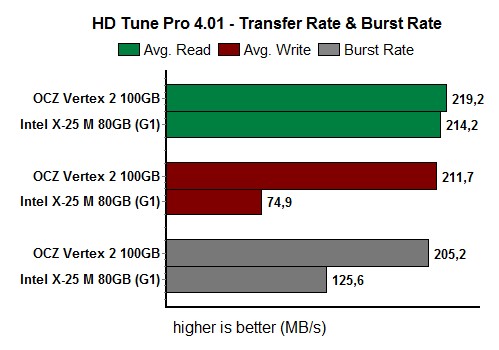

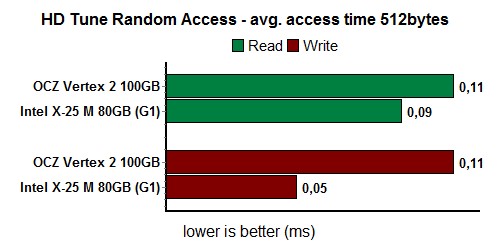

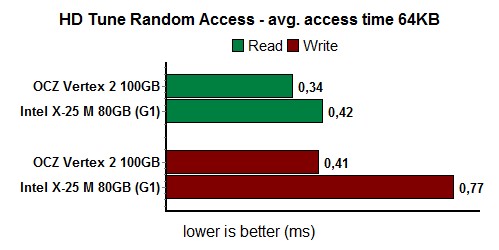

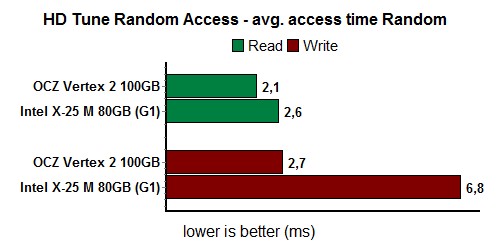
Atto Disk Benchmark
Atto disk benchmark is a pretty reliable tool for testing maximum possible transfer speeds on SSD and HDD devices. Good thing about it is that it allows for testing with predefined block sizes, and the results are neatly organized and displayed. It’s also one of few tools on which you can rely on when testing SSDs.
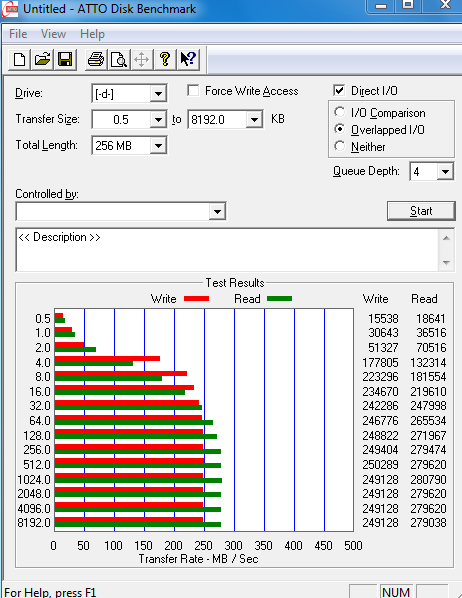

Compared to many other SSDs, Vertex 2 has an upper hand when it comes to write speeds. Atto test didn’t see Vertex 2 reach maximum possible value of 275 MB/s, but it did go over 250 MB/s. Read speeds on Vertex 2 can hit almost 285 MB/s, and Atto test confirms this. Note that this is almost the limit of the SATA II controller.
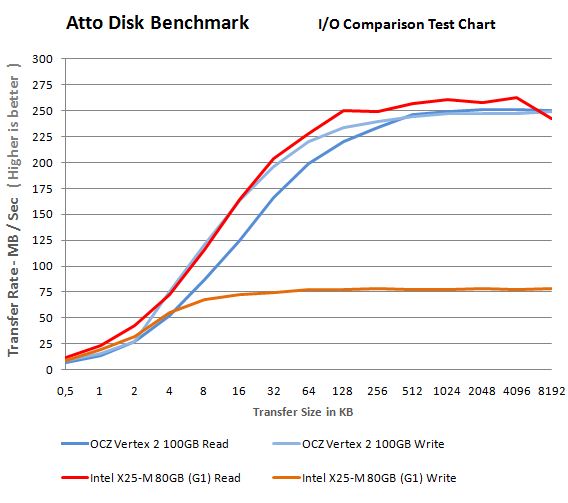
PCMark Vantage
PCMark Vantage features a nice set of HDD tests, and they can just as easily be applied to SSDs and paint a general picture of the drive’s everyday operation. HDD test suite comprises of 8 tests which touch upon pretty much all facets of working with a computer – from multimedia to operating system load times, with average performance results listed at the end.
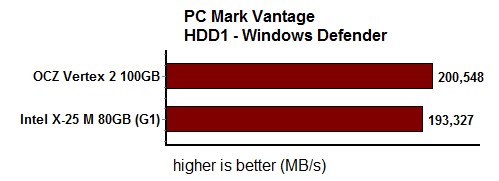
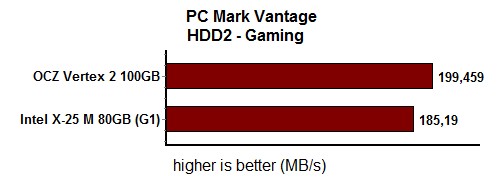
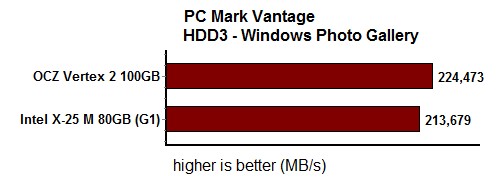
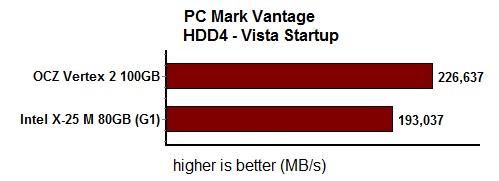
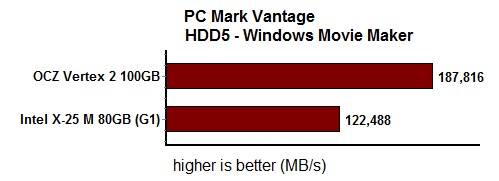
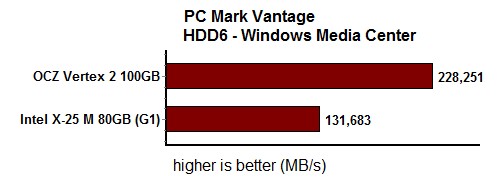
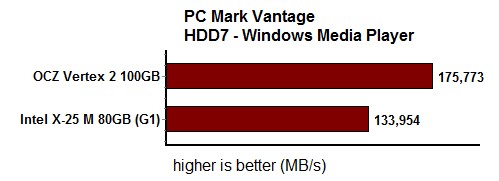
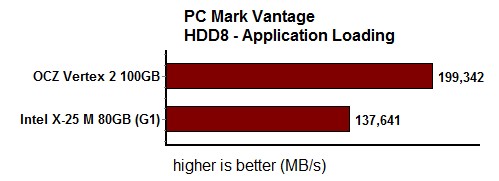
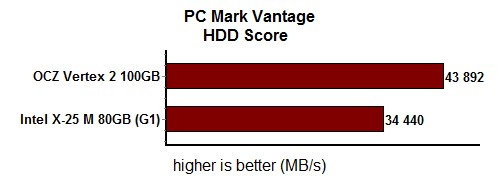
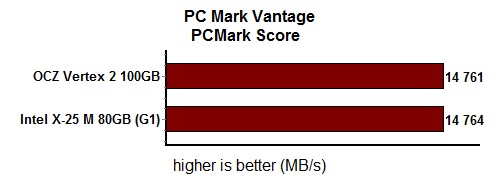
HDD results show Vertex 2 100GB’s hefty advantage over the old Intel X-25M 80GB G1 (firmware 8820), but PCMark Vantage’s overall performance results still favor Intel’s drive, which utilizes its parallel architecture in the best possible way. Still, OCZ’s Vertex 2 is better in sequential writing, where Intel is limited to 80 MB/s, so Vertex 2 scored better in HDD suite.
AS SSD Benchmark
AS SSD Benchmark is one of our favorite SSD and HDD benchmark tools, which displays average values rather than maximum ones.
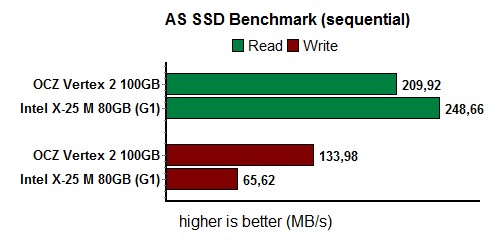
With 134 MB/s in sequential writing, Vertex 2 is almost twice faster than Intel’s X-25 M 80GB G1, but we found that it ran better in sequential writing of well compressed data.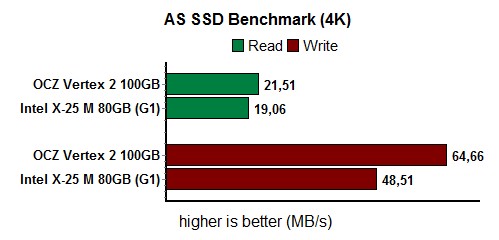
Random reading and writing of 4KB data is a job made for Sandforce and Vertext 2. 64 MB/s write speed is a great result that not many SSDs will manage.
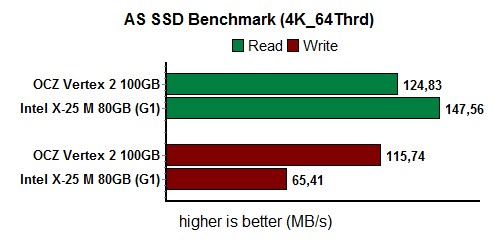
We expected Intel to fare well in 4K_64Thrd test, because Native Command Quein (NCQ) plays a crucial role – 64 threads for random memory access is regulated and optimized by software in order to achieve maximum transfer speed. Vertex 2, with its optimized firmware, again shows that write speeds are its trade. Queue depth of 64 is unrealistically high for a regular computer, but Vertex 2 shows that it’s capable of Workstation operation as well.
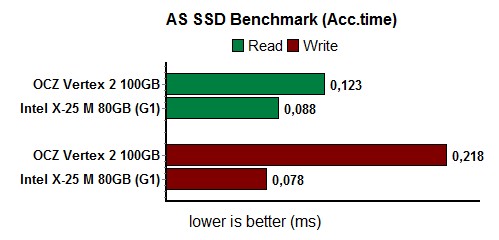
Write access times were pretty good but we were surprised with the low scores in read access time, where Vertex 2 should be on par with Intel’s drive. Repeating tests didn’t do anything to improve results but 0.123ms is still a respectable result.
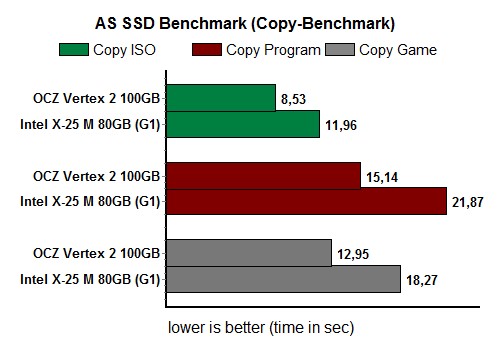
Copying files is a part of AS SSD benchmark and is perhaps more practical than previous tests. Vertex 2 shows that it’s not only good in synthetic tests. Furthermore, we see that copying compressed files is the fastest.
Crystal Disk Mark 3.0 x64
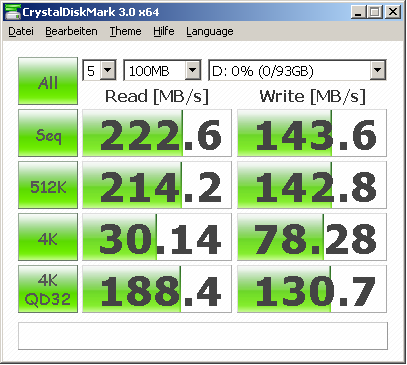
CrystalDiskMark test results (sequential read/write) show identical performance ratios for the two SSDs, which coincides with AS SSD benchmark results as Vertex 2 100GB has a hefty write advantage over Intel’s X-25 80GB G1.
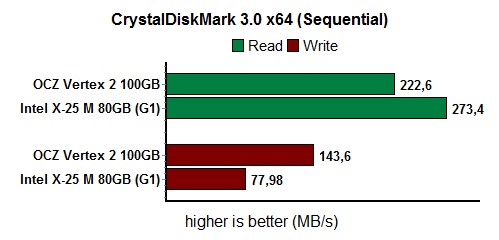
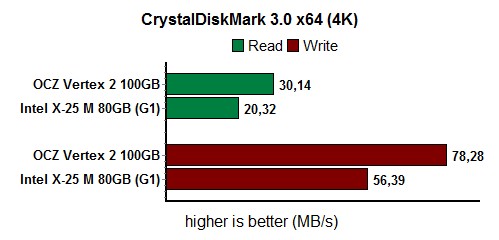
SiSoft Sandra 2010
Sandra confirms Vertex 2 100GB is really fast, although we couldn't manage maximum 285MB/s read. 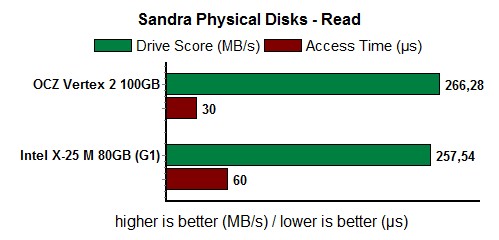
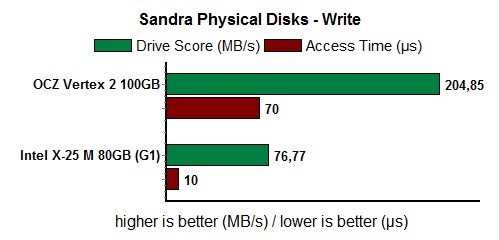
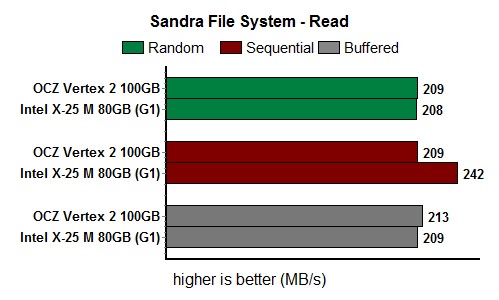
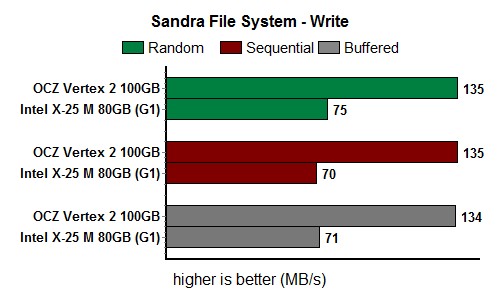
Iometer
Iometer was made by Intel back in 1998 as an I/O subsystem measurement and characterization tool for single and clustered systems, but is open source as of 2001 and is considered a standard benchmark. It’s used for benchmarking SSDs as well, but whether it shows actual, real-life performance is debatable.
We moved on to key tests with varying queue depths, simulating Workstation and Database operation. Queue depth in simple terms means how many commands are stacked on the SSD in a given period of time. This determines how much IO the OS (or application) will ‘allow’ the underlying controller to optimize. By re-ordering and combining commands, physical IO can be streamlined or reduced by the controller. The more commands the controller can process in this way before needing to report something back to the OS, the better the ’hit-rate’ of such optimizations (and hence the higher the ultimate throughput), but the trade-off is latency, which can have a devastating impact on the user experience.
It’s important to note that we’ve configured access specifications (Align I/Os on) to 4KB.

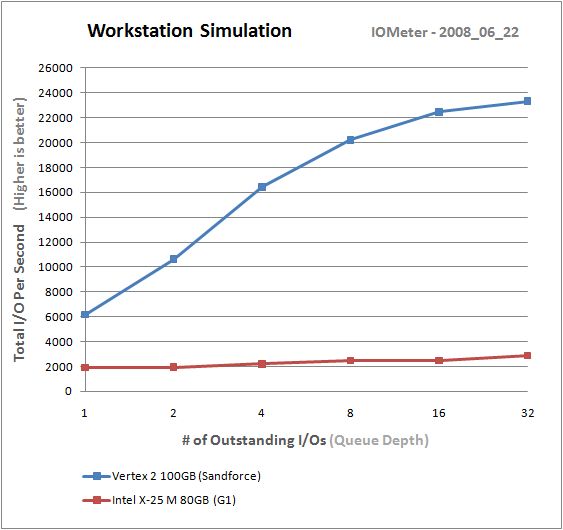
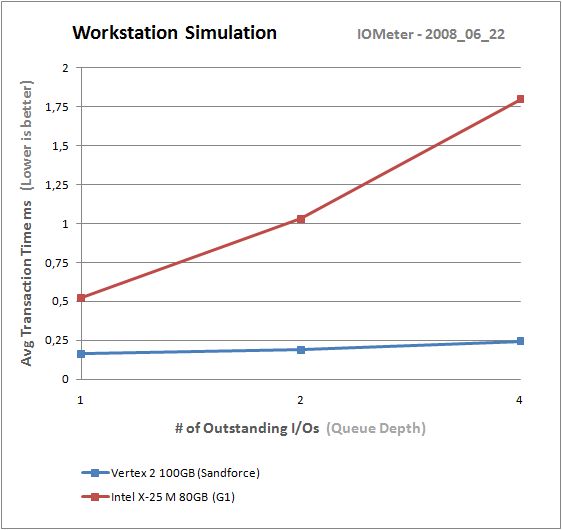
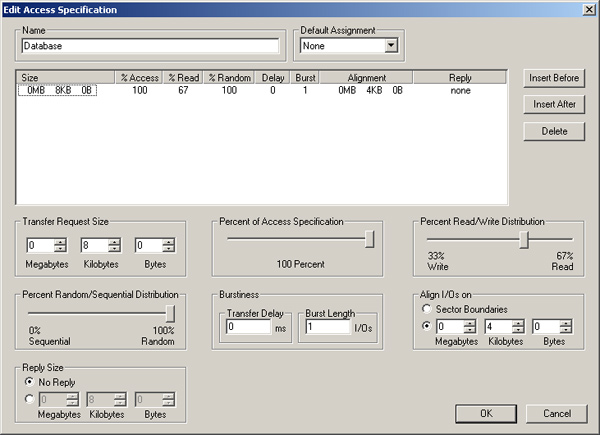
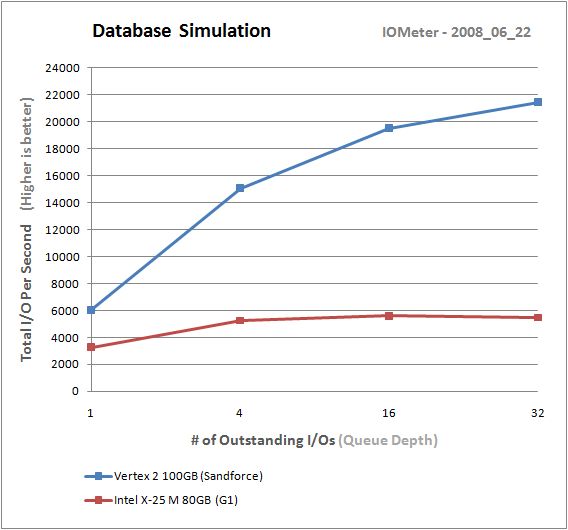
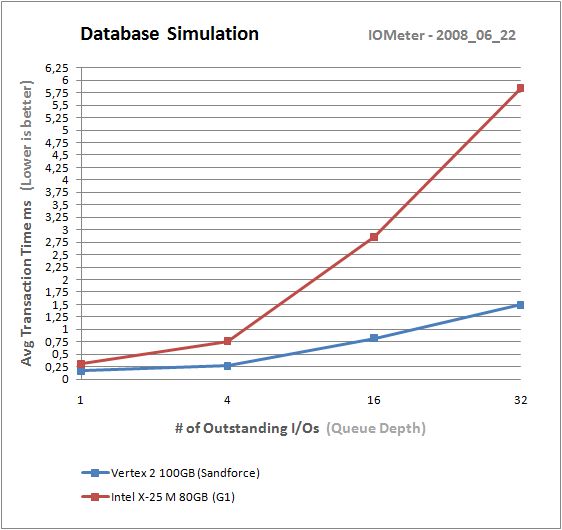
We tested 4K write with QD 21 as well, where Vertex 2 should, according to the specs, score about 50000. We managed 47000, which is a fascinating result. 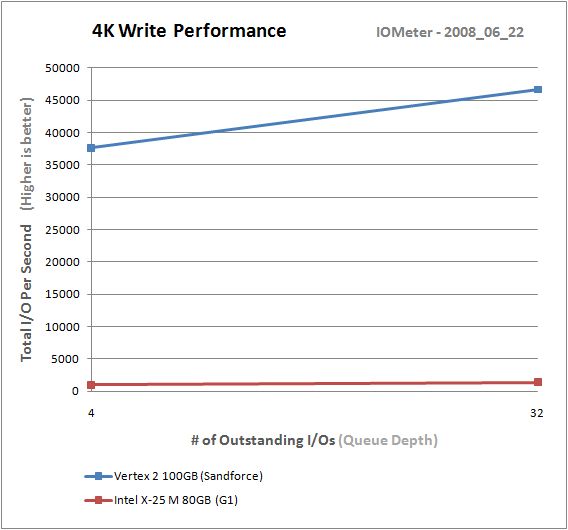
Conclusion
Throughout our tests, Vertex 2 has proven to be the crème of the crop of the current SSD offer. We measured 280MB/s read and 250 MB/s write speeds, whereas 4K file writing tests saw Vertex 2 hit spectacular 46,654 IOPS. These results show that users will benefit from Vertex 2 in multitasking and general response of their OS of choice. Talking about speeds, Vertex 2’s specs list 285MB/s read and 275MB/s speeds.
OCZ’s new drive uses Sandforce 1200 controller, which is already popular with leading SSD manufacturers, but OCZ optimized the firmware and pushed Vertex 2’s random IO performance in writing 4K files through the roof. For future firmware updates, seruce erase or reverting the drive to factory settings OCZ is preparing its OCZ Toolbox software utility, which will perform all this operations from Windows. Firmware supports TRIM, which means that Windows 7 users will be able to maintain Vertex 2’s top performance longer.OCZ offers as much as eight Vertex 2 SSD drives, all of them differing in capacity but being identical in terms of sustainable performance. Don’t be confused by the fact that OCZ offers standard and extended versions of Sandforce Vertex 2 drives – the speeds are the same it’s just that the extended versions come with slightly higher capacity. Naturally, since price per GB is a big factor here, extended versions seem to be much better investments. Our today’s Vertex 2 100GB is priced at €320 (€3,2 per GB) whereas the 120GB, extended version is priced at about €314. If Vertex 2 100GB drives are too pricey for you and you don’t need so much space but would very much like to treat yourself to an SSD, then Vertex 2 60GB might be a wise choice; it’s priced at about €164 (€2,72 per GB).
In conclusion, no matter which Vertex 2 drive you choose, you’ll find these drives to be quality, durable components that offer reliable performance, whether it’s Workstation PC, Desktop PC or Notebook PC.